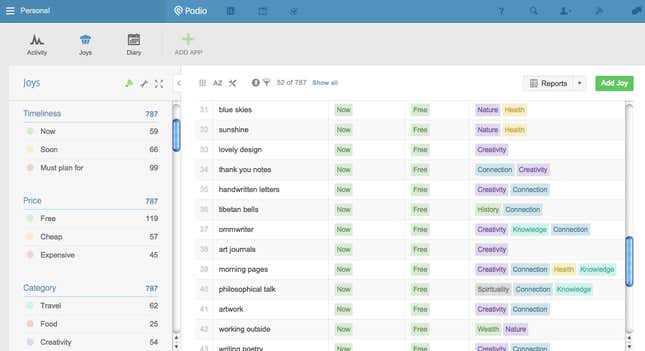Normally I’m a positive, productive member of society. But I do have episodes of depression that make even getting out of bed difficult.
There’s a stigma associated with even saying that much, but I’m open to writing about it. Maybe some of the tools that I’ve found to help me manage my depression can help someone else.
Like, for example, my Spreadsheet of Happiness.
People who know me know I love spreadsheets. They’re just so orderly and sensible in a chaotic, nonsense world. How could you not love them?
I was feeling horrible one day and decided to reach out to my Facebook friends. I needed a nudge out of my mental state, so I asked, “What are some everyday things that give you joy?”
The lists poured in: “coffee,” “my cat,” “sunrises,” “flowers,” “books.” Some answers were standard; some were surprising and very specific.
Then I started making a list of my own: Morning light. Forests. The ending of Amelie. Old, abandoned warehouses.
My list kept growing. And growing. And before I knew it, I had more than 700 items.
One of those items was spreadsheets, so naturally I made a spreadsheet out of the list. My spreadsheet came complete with categories I can sort, such as “does this thing cost me money” and “can I access this thing now or later.”

If I’m feeling broke and stuck and need an activity to lift my spirits immediately, I have a filter that shows me all of the stuff I can do for free, right now. If I want to work toward a larger goal—say, a reward for exercising three times a week, which is another one of my depression-management tools—I can sort by the items that need some planning.
As I noticed certain themes emerge on my list, I created another column to categorize the items by subject, such as “travel,” “connection,” and “creativity.” This helped me to see more clearly the kinds of things that excite me. If I’m feeling deficient in any of those areas, I can sort the spreadsheet to see what can jump-start that area of my life. I even imported the spreadsheet into my favorite project management platform, called Podio.
The act of sorting and sifting and importing puts me back in touch with the 700-plus things on the list, and each time, I get a tiny dose of dopamine. Little by little, item by item.
A trip to England. A blue sky. The view of the San Francisco skyline. An inside joke. A window seat on a plane.
Now I can track each day whether I’ve done or experienced any of the things on my Spreadsheet of Happiness. The simple act of remembering, “Yes, I just did this thing that makes me happy,” makes me happy and present. It forces me to focus my brain on the positive in the here and now.
None of this is a replacement for a proper diagnosis and treatment for depression. And this won’t work for everyone. Sometimes I need to be in my depression fully and completely, without judgment, without the need to fix all the bad feelings. I let myself be sad if I need to, and I reach out for help when it feels like too much.
But any avenue I can use to reinforce a positive outlook is, in my case, medically necessary. Depression means my brain has a bias toward the negative, and biases lie.
Since my brain is lying anyway, I figure I might as well balance that negativity out with another bias—one that might actually get me out of bed in the morning.
